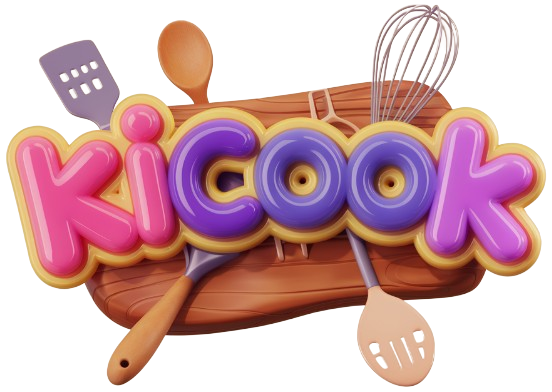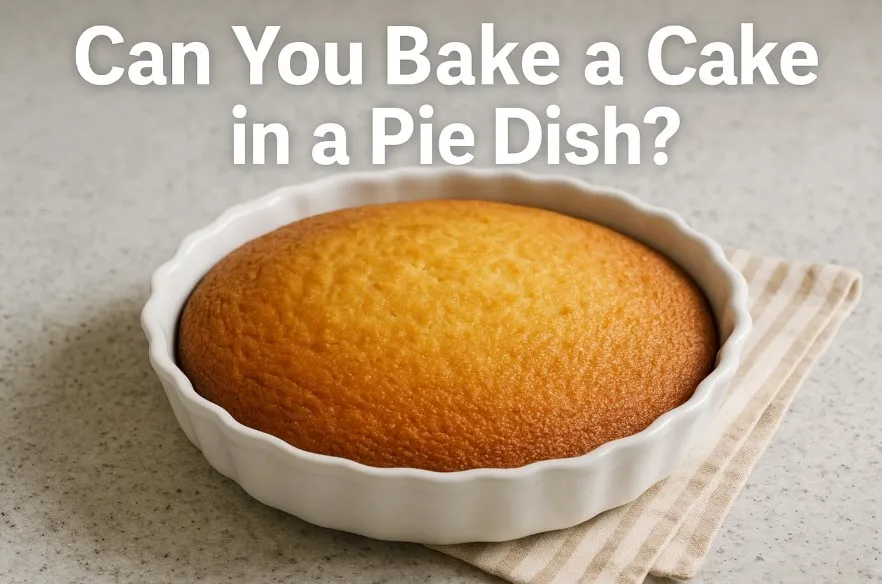Absolutely! A pie dish can work for cakes—just adjust baking time (may be slightly longer) and fill only 2/3 full to prevent overflow.
Ever found yourself digging through your kitchen cabinets for a cake pan, but all you can find is a pie dish? Last month, right before my daughter’s birthday, I had that exact “oh no” moment. But did I panic? (A little.)
Did I improvise? Absolutely! Here’s what I learned from swapping out my trusty cake pan for a pie dish—and some fun surprises along the way. Spoiler: not all heroes wear aprons, and not all cakes need fancy pans. Lets explore “Can You Bake a Cake in a Pie Dish?”

“Baking is both an art and a science. A pie dish can work for cakes, but patience and small adjustments make all the difference.” – Julia Child
Pie Dish vs. Cake Pan: My Kitchen Showdown
It started with a classic kitchen emergency: I’d promised a chocolate sheet cake for a friend’s birthday, but when I reached for my trusty cake pan, it was nowhere to be found. After a few frantic minutes of searching, I spotted my glass pie dish sitting quietly on the shelf. Could I really bake a cake in a pie dish? With no time to spare, I decided to give it a try. What followed was a surprisingly enlightening experiment in the world of bakeware.
Shape Matters: Pie Dish vs. Cake Pan
At first glance, a pie dish and a cake pan might seem interchangeable, but there are some key differences. A standard pie dish is typically 9 inches in diameter and holds about 1 to 1.25 quarts. The sides are slanted and the dish is shallower. In contrast, cake pans—whether round or square—are usually deeper, with straighter edges. For example, a 9-inch round cake pan is about 2 inches deep. These differences in shape directly impact how your cake bakes and looks.
| Pan Type | Diameter | Depth | Capacity |
|---|---|---|---|
| Pie Dish | 9 inches | ~1.25 inches | 1–1.25 quarts |
| Cake Pan | 8 or 9 inches | 2 inches | Varies |
Material Differences: Ceramic, Glass, and Metal Pans
Another factor I hadn’t considered until this experiment: the material of your bakeware. My pie dish was glass, which heats up slower than the metal pans I usually use for cakes. Research shows that ceramic pans and glass pans retain heat longer and distribute it more gently, which can affect how evenly your cake bakes and how brown the edges get.

Metal pans, on the other hand, heat up quickly and promote a more even rise and browning. This is why cakes baked in metal pans often have a lighter, fluffier texture compared to those baked in ceramic or glass pans.
What Changed When I Used a Pie Dish?
Once my chocolate sheet cake came out of the oven, the differences were obvious. The cake had a slightly chewier edge—likely due to the slanted, shallower sides of the pie dish and the slower heat transfer from the glass. But it also had a gloriously rustic look, with a golden, slightly crisp edge that I actually loved. The center was moist, and the cake held together well when sliced. The only real adjustment I had to make was keeping an eye on the baking time; it took a few minutes longer than usual.
“You can absolutely bake cakes in pie dishes, especially for sheet-style cakes.” – Jenny Steffens Hobick
Lessons Learned (and a Few Surprises)
- Pie dishes are shallower and have slanted sides, while cake pans are deeper with straight edges.
- Ceramic pans and glass pans heat up slower than metal pans, which impacts browning and texture.
- Swapping a cake pan for a pie dish will change your cake’s appearance and texture, but it’s absolutely doable—especially for sheet-style cakes.
So, if you ever find yourself in a pinch, don’t hesitate to reach for that pie dish. The results might just surprise you.
Surprising Bake-Off: How Different Pans Change the Game

When I set out to answer the question, “Can you bake a cake in a pie dish?” I didn’t expect to learn so much about the science of cake baking and pie baking. To get a real answer, I decided to run a little experiment: I baked my mom’s classic coffee cake recipe twice—once in a traditional cake pan, and once in a standard glass pie dish. The results were more surprising than I expected, and they taught me some valuable baking tips that I’ll be using from now on.
Testing the Waters: Coffee Cake in Two Pans
First, let’s talk about the bake. The cake pan was my control—metal, non-stick coating, and what I’ve always used for this recipe. The pie dish, on the other hand, was glass and a bit shallower. I lined both with parchment paper, just to keep things fair and to test the advice I’d read about easier removal and cleanup. (Spoiler: parchment paper is a game-changer.)
Baking Times: Edges vs. Center
Here’s where things got interesting. The coffee cake in the pie dish baked up with edges that were noticeably faster to brown and crisp. The center, though, lagged behind—still a bit undercooked when the edges were perfect.
This is a classic case of how different pan materials and shapes affect heat transfer. Research shows that ceramic and glass pans (like my pie dish) heat more slowly than metal, so the outer edge cooks first. If you’re using a pie dish for cake baking, keep a close eye on the center and consider lowering your oven temperature or tenting the edges with foil to prevent over-browning.
Texture Talk: Crispier Perimeter, Softer Center

The texture difference was clear. The cake from the pie dish had a crispier, almost caramelized perimeter—honestly, it was perfect with a scoop of vanilla ice cream. The cake pan version, meanwhile, was more even throughout. If you love a little crunch with your cake, the pie dish might be your new secret weapon.
Pan Prep: Non-Stick Coating and Parchment Paper
Let’s talk about getting your cake out of the pan. Non-stick coatings are helpful, but parchment paper takes it to another level. Lining the pie dish with parchment let me lift the entire cake out in one piece—no sticking, no crumbling, and no stress. As the AllRecipes Editorial team puts it:
“Using a parchment-lined cake pan—or pie dish—makes for a much easier cleanup.”
This tip isn’t just for cake baking. Studies indicate that using parchment paper in cake pans or pie dishes can make slicing pies easier and improve cleanup by allowing the whole pie to be lifted out before cutting. It’s a simple upgrade that saves time and frustration, especially when you’re baking for a crowd.
Quick Reference Table: Pan Materials and Baking Tips
| Pan Feature | Baking Impact |
|---|---|
| Ceramic/Glass Pans | Slower heat transfer; edges cook first |
| Non-Stick Coating | Easier removal of cake or pie |
| Parchment Paper | Recommended for pie dish cakes; allows neat lifting and slicing |
Different pan types—metal, glass, ceramic—really do change the game. Non-stick coatings and parchment paper aren’t just nice-to-haves; they can save your cake’s life (and your sanity) in the kitchen. If you’re experimenting with pie baking or cake baking in new pans, these baking tips are worth remembering.
Not Just Cakes: Creative Pie Dish Hacks and Cautions
When I first wondered if I could bake a cake in a pie dish, I wasn’t just thinking about cake. Pie dishes, it turns out, are surprisingly versatile—and not just for classic pie baking. Over the years, I’ve experimented with all sorts of baking alternatives, from deep-dish apple cobbler to quiche and even brownies. (If you love chewy edges, brownies in a pie dish are a game-changer.) But as with any kitchen hack, there are a few things to keep in mind before you swap out your usual pans.
Let’s start with the basics. Pie dishes come in all sorts of materials—glass, ceramic, metal—and each one handles heat a bit differently. Glass and ceramic tend to heat more evenly but can take longer to brown the crust, while metal heats up fast and can give you a crisper edge.
If you’re looking for extra browning or want to avoid a soggy-bottomed crust, here’s a tip I picked up: try placing your pie dish on a preheated pizza stone. Research shows that a pizza stone helps set the crust quickly, giving you that golden, crisp base that’s so satisfying in both pies and savory bakes.

Now, about those deep-dish pans. If you’ve ever tried to fit a fruit cake or bread pudding into a standard pie dish, you know the struggle. Deep-dish pans are a lifesaver here, offering more capacity for filling and making them ideal for fruit or meat pies. Studies indicate that deep-dish pans are especially suitable when you need extra room for dense batters or chunky ingredients.
But don’t get carried away—overfilling a shallow pie dish with a runny batter can lead to overflow and a sticky oven mess. I learned this the hard way with a particularly ambitious chocolate cake. Lesson learned: always check the depth of your dish before pouring in the batter.
Of course, not every pie baking technique translates to cakes. Blind baking—pre-baking the crust with pie weights—is a must for pies with wet fillings, but it’s unnecessary (and a bit odd) for cakes. The same goes for egg wash. While it gives pies that beautiful golden finish, it’s not something you need for cake batter. Save those tricks for your next quiche or fruit pie.
Pie dishes are great for more than just pies, but they do have their limits. If you’re baking something with a very liquid batter, like a custard-heavy cake, be cautious. Soggy-bottom syndrome is real, especially in dense cake recipes. And while it’s tempting to use whatever pan is clean, sometimes a cake pan really is the better choice—especially if you want neat slices and easy removal.
“Baking is part science, part art, part using what’s clean when you forgot the cake pan.” – Me (and probably you, at some point)
Frequently Asked Questions for Can You Bake a Cake in a Pie Dish
Can I use a metal pie tin for cakes?
Yes! Metal conducts heat faster, so reduce baking time by a few minutes.
Will my cake bake evenly in a pie dish?
Glass and ceramic dishes bake evenly but may require slight temperature adjustments.
Can I make a layered cake in a pie dish?
It’s tricky due to the sloped sides, but you can bake a single layer and slice it horizontally.
“The best bakers adapt. If a pie dish is all you have, make it work—creativity is key.” – Mary Berry
Tips for Success
- Use parchment paper for easy removal.
- Monitor closely – Pie dishes can brown edges faster.
- Experiment – Try different recipes to see what works best.
Conclusion
So, can you use a pie dish for baking cakes? Absolutely! While it’s not ideal for every cake type, with a few tweaks, you can bake delicious cakes in a pie dish. Just remember to adjust the batter, keep an eye on baking time, and choose the right recipe.
Happy baking!
“Good baking isn’t about having the best tools—it’s about knowing how to use what you have.” – Paul Hollywood

